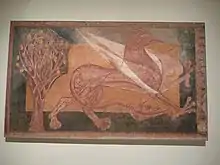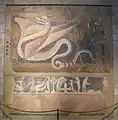Paintings from Arlanza
The paintings from Arlanza are a set of frescos belonging to the mural decoration of a Benedictine monastery of San Pedro de Arlanza, in the Province of Burgos, Castile and León, Spain, dating to around 1210, and now dispersed among a number of collections. The Spanish government began to detach and sell sections of the frescos in the 19th century, though less exciting sections remain in situ. The largest group of six major fragments has moved to the National Art Museum of Catalonia of Barcelona in 1943. Most of the Romanesque mural painting that has survived is of religious subjects, but there was also find decoration of a courtly or profane nature in large monastic centres, such as Arlanza in Castile, and these fragments represent especially rare survivals.[1] According to C. R. Dodwell, the "imposing" Arlanza paintings are "endowed with all the power and grandeur of Romanesque at its best".[2]
Description
The ten very large animals and other subjects from the world of heraldry[3] come from the chapter house or a room above,[4] on the lowest floor of the so-called Torre del Tesoro (Treasury Tower), and are inspired by illuminated bestiaries, with the basic landscape backgrounds that are often seen in these. The Barcelona group includes a gryphon, a legendary creature with the body of a lion and the head and wings of an eagle, in a watchful pose. The MNAC has 5 more fragments from the same decorative group. There are other panels of a lion and a dragon, now at The Cloisters in New York,[5] one at the Harvard University Fogg Art Museum,[6] and another in a private collection.
The style of the paintings in Arlanza is related to other Spanish works of around 1200, especially the frescos from the Monastery of Santa María de Sigena (also in MNAC, Barcelona), which are clearly influenced by English illuminated manuscript miniature painting, something that can be seen in the refinement and the precision of the motifs, combined with their monumental nature.[7] The Sigena frescos, which are probably actually largely by English artists, namely some of the team who illuminated the Winchester Bible,[8] also contain a very similar gryphon and lion,[9] and are possibly by the same principal artist.[10] The Arlanza fragments in New York still include their section of the black and white frieze with more figures including fabulous beasts running below the large polychrome animals.
Notes
| Wikimedia Commons has media related to Monasterio de San Pedro de Arlanza. |
- entry at the MNAC website
- Dodwell, 268
- Dodwell describes them as "over life-size", somewhat begging the question in the case of the dragon and other mythical beasts
- Sources are oddly variable on this
- Cloisters lion
- Fogg Art Museum fragment
- entry at the MNAC website; also see Cloisters
- Dodwell, 372-373, and Oakeshott throughout
- Oakeshott: Gryphon, figures 207 (Arlanza) and 208 (Sigena), Sigena lion figure 42; the Sigena gryphon, after fire damage, can be seen at right in this photo.
- Dodwell, 268
Further reading
- Castiñeiras, Manuel; Camps, Jordi (2008). Romanesque art in the MNAC collections. MNAC. ISBN 978-84-8043-196-5. Retrieved 3 September 2012.
- Museu Nacional D'Art de Catalunya. MNAC. 1 March 2009. ISBN 978-84-8043-200-9. Retrieved 3 September 2012.
- Carbonell, Eduard; Pagès, Montserrat; Camps, Jordi; Marot, Teresa (1998). Romanesque Art Guide: Museu Nacional D'Art de Catalunya. Museu Nacional d'Art de Catalunya. Retrieved 3 September 2012.
- Carbonell, Eduard; Sureda i Pons, Joan (1997). The Medieval Treasures of the Museu Nacional D'Art de Catalunya. Lunwerg. Retrieved 3 September 2012.
- Dodwell, C.R.; The Pictorial arts of the West, 800-1200, 1993, Yale UP, ISBN 0300064934
- Oakeshott, Walter, Sigena: Romanesque Painting in Spain & the Winchester Bible Artists, London, 1972, Harvey, Miller and Medcalf. ISBN 0-8212-0497-1






.jpg.webp)

